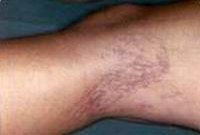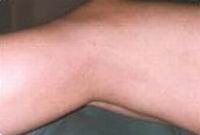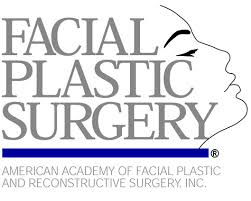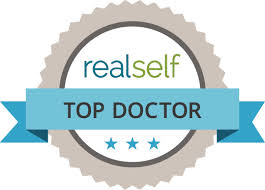Leg Vein Laser
What are veins?
Veins are the blood vessels responsible for returning blood to the heart. Within our legs, the veins have to bring the blood up the body and against gravity. In order for veins to return this blood to the heart they require valves. These one-way valves are very thin, yet are able to hold up against the pressure of gravity pushing down on the blood against the valve.
What are spider veins?
Spider veins are the more superficial vessels in the skin, usually only a cosmetic nuisance. They can be 4-5 mm wide blue veins and as small as 1mm tiny red spider veins.
Spider veins are not always directly caused by varicose veins, but before treatment you should be evaluated to make sure there are no varicose veins present. If there are varicose veins present and not treated, the spider veins will require many more treatment than usual, and may not respond to treatment at all. If there are no varicose veins present, spider veins typically respond very well to treatment.
How are spider veins treated?
Once varicose veins have been ruled out or treated spider veins can be treated very effectively.
All treatments for spider veins can cause the veins to appear red and inflamed or bruised immediately after the treatment and this can last for several days. You may also be asked to wear compression stockings for 48 hours after treatment to maximize treatment benefits. Generally, no activity restrictions are necessary after the treatment of spider veins. There are different treatment options for spider veins:
Vasculight. Nd:Yag laser is utilized to treat the deeper spider veins that appear blue under the skin. Eye protection will be provided and gel applied to the skin before treatment. A cooling unit will be used to increase the comfort of the treatment, as there can be a stinging sensation with each pulse.
Intense Pulsed Light (IPL). This non-invasive treatment is used for the more superficial spider veins in the skin, using lower wavelengths of light more readily absorbed by the red blood cells. IPL treatment does have some stinging sensations during treatment as well, but is more appealing to patients because it does not use needles or incisions. A cooling unit will be used to increase comfort during treatment. Multiple treatments are usually necessary, and it is very important to protect the skin from sun exposure before, during, and after all treatments. As the veins clear, it is okay to resume sun exposure. Risks of IPL treatments include redness, inflammation, and bruising of the vessels. There is less chance of staining of the skin, but with sun exposure after treatment the risk increases. Blistering and permanent scarring are less common.
Sclerotherapy. Injection of a sclerosing agent (a medication to chemically close the vein) into spider and reticular veins is an in office procedure using a small needle causing them to eventually collapse and fade. This can take multiple treatments. Risks include ulceration of the surrounding skin (which can cause scarring), bruising, and staining of the skin, and a mild to severe reaction to the sclerosing agent. Staining of the skin can last for 6 to 12 months and in some cases is permanent. Sun exposure should be minimized to reduce the possibility of staining the skin as the veins are re-absorbed by the body.


Before After
Treatment of spider veins on the legs. * Individual results may vary.
How does IPL for spider veins and vascular lesions work?
Laser and intense pulsed light (IPL) pulses are directed at the spider veins as well as vascular birthmarks. The tissue targeted is the hemoglobin in the blood. A highly advanced computer regulates the light pulse to a specific wavelength range, which in turn heats the visible, targeted blood vessel(s), thereby damaging or otherwise destroying the targeted lesion while sparing the surrounding healthy or normal tissue. Over time the destroyed veins are reabsorbed and disappear.
The key to effective treatment of vascular lesions is in finding the optimal wavelength in which absorption of the hemoglobin (in the blood vessels) is maximized. Certain wavelengths of light maximize this absorption - which results in effective vein treatment.
Identifying the correct wavelength to use on your skin is critical to your outcome. Therefore, it is essential that your provider not only be extremely knowledgeable in laser technology, but that a Physician well trained in laser physics be present to assess the efficacy of your treatment. Most laser clinics cannot offer this to you like Dr. Naficy's Plastic Surgery & Rejuvenation Center can.
How many treatments will I need?
Results are unique to each individual depending on several factors including the extent and size of the veins being treated. Typically a number of treatments are necessary for optimal results. Treatments should be performed over one month intervals in order to accurately assess progress, and adjust settings as necessary.
Am I a good candidate for IPL?
New technology is making IPL treatments effective for most skin types. Dr. Naficy and his trained staff will personally assess your skin to determine whether you are a good candidate for IPL treatment for spider and varicose veins.
Are treatments painful?
You will feel some discomfort, which can be minimized by using a topical anesthetic (numbing cream) or by using a cooling mechanism such as the Zimmer.
What will happen after the treatment?
You may experience temporary redness, itching, bruising and/or swelling in the treated area, but this typically lasts a very short time and most people return to work or normal activity immediately after treatment.
What causes spider veins?
There are many factors that increase a person's chances of developing varicose veins.
- Increased age
- Heredity. This is the leading factor in developing varicose and spider veins. Having family members with vein problems or being born with weak vein valves.
- Hormonal changes. These changes can occur during puberty, pregnancy, and menopause. Taking hormones also increase the risk of developing varicose or spider veins. Changes in hormone levels can weaken vessel walls and valves.
- Pregnancy. During pregnancy there is an increase in the amount of blood in the body, potentially causing veins to enlarge. This increased volume of blood and expanding uterus put pressure on veins. The veins appearing during pregnancy often improve after birth, but the number of abnormal veins can increase with each additional pregnancy.
- Obesity, leg injury, and prolonged standing can weaken vein valves.
- Sun exposure. The heat from sun exposure can dilate blood vessels.
How can I prevent varicose and spider veins?
Varicose and spider veins cannot always be prevented, but some things can reduce the chances of getting new veins or worsening the existing veins.
- Sunscreen. Protecting your skin from sun exposure can decrease the dilation in surface veins.
- Exercise. Regular exercise can improve leg strength, circulation, and vein strength. Walking and running are great for focusing on strengthening the legs.
- Weight. Controlling weight to avoid putting too much pressure on your legs.
- Do not cross your legs or ankles while sitting.
- Elevate your legs as much as possible when resting.
- Do not stand or sit for prolonged periods of time. If you must stand for a long period, shift your weight from one leg to another every few minutes. If you must sit for prolonged periods of time stand up and move around every 30 minutes.
- Wearing graduated compression stockings can encourage blood flow up the legs, minimizing pooling of blood in the legs.
- Eat a high fiber diet. Fiber in the diet reduces constipation which can contribute to varicose veins.
- Eat a low salt diet. Increased amounts of sodium in the diet can increase water retention and swelling.
Should I be doing anything in preparation for my treatment?
You should avoid sun exposure and tanning (including artificial tanning products and procedures) before and after your treatments. Also, you should discontinue the use of any blood thinners such as Coumadin, aspirin or other types of anti-platelet or anti-coagulant herbal remedies including Garlic, Ginger, Cayenne, Gingko, Gingko biloba, Selenium, Papaya, Bilberry and Vitamin E Tablets/Supplements.
Contact Us
If you are interested in Leg Vein Laser please fill out this Laser Inquiry Form. You will find our staff to be knowledgeable, professional, accommodating, and honest.






